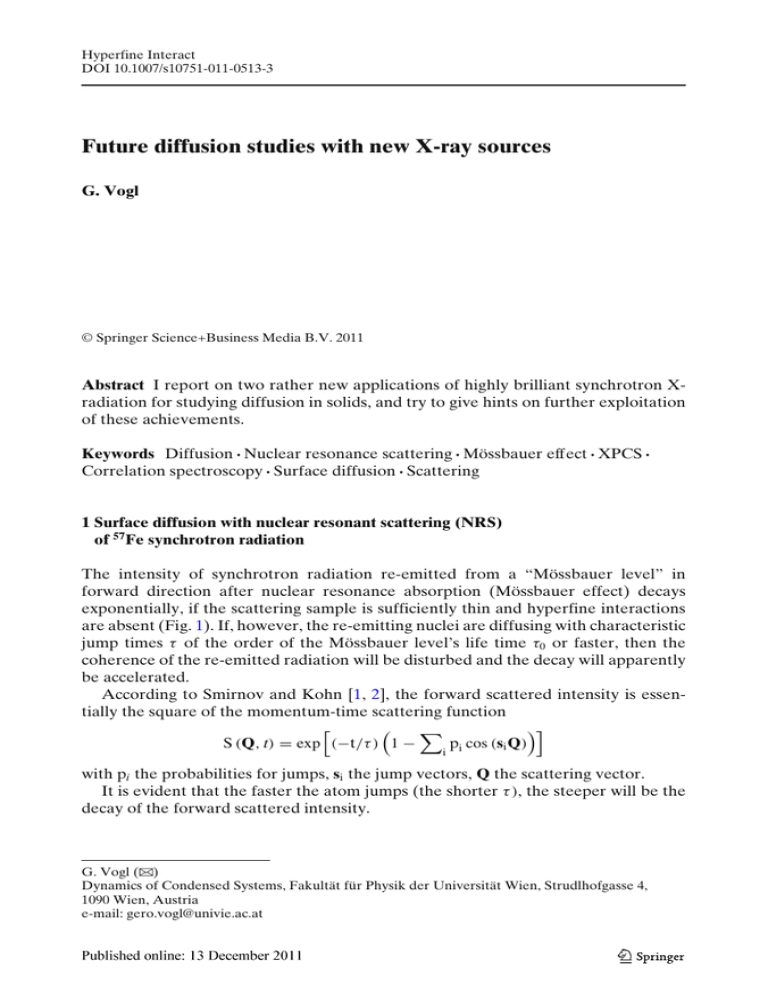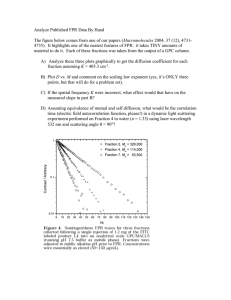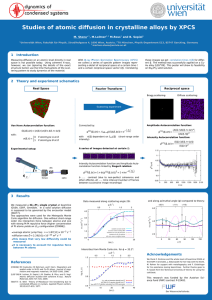Future diffusion studies with new X
advertisement

Hyperfine Interact DOI 10.1007/s10751-011-0513-3 Future diffusion studies with new X-ray sources G. Vogl © Springer Science+Business Media B.V. 2011 Abstract I report on two rather new applications of highly brilliant synchrotron Xradiation for studying diffusion in solids, and try to give hints on further exploitation of these achievements. Keywords Diffusion · Nuclear resonance scattering · Mössbauer effect · XPCS · Correlation spectroscopy · Surface diffusion · Scattering 1 Surface diffusion with nuclear resonant scattering (NRS) of 57 Fe synchrotron radiation The intensity of synchrotron radiation re-emitted from a “Mössbauer level” in forward direction after nuclear resonance absorption (Mössbauer effect) decays exponentially, if the scattering sample is sufficiently thin and hyperfine interactions are absent (Fig. 1). If, however, the re-emitting nuclei are diffusing with characteristic jump times τ of the order of the Mössbauer level’s life time τ0 or faster, then the coherence of the re-emitted radiation will be disturbed and the decay will apparently be accelerated. According to Smirnov and Kohn [1, 2], the forward scattered intensity is essentially the square of the momentum-time scattering function S (Q, t) = exp (−t/τ ) 1 − pi cos (si Q) i with pi the probabilities for jumps, si the jump vectors, Q the scattering vector. It is evident that the faster the atom jumps (the shorter τ ), the steeper will be the decay of the forward scattered intensity. G. Vogl (B) Dynamics of Condensed Systems, Fakultät für Physik der Universität Wien, Strudlhofgasse 4, 1090 Wien, Austria e-mail: gero.vogl@univie.ac.at G. Vogl Fig. 1 The logarithm of the intensity of NRS from 57 Fe in forward direction decays linearly with characteristic time of 141 ns in absence of diffusion (red line). When the scattering atoms diffuse, the coherence of the forward scattered beam is lost and the decay is accelerated (blue line) Fig. 2 Diffusion of iron atom by help of a vacancy in surface monolayer on tungsten. The arrows symbolize synchrotron X-radiation incoming and scattered in grazing incidence geometry Diffusion of Fe in surface monolayer on W Synchrotron beam in grazing incidence This has been experimentally proven by Sepiol et al. [3, 4] in 1999. The results for diffusion of iron in intermetallic alloys agreed essentially with the results from conventional Mössbauer spectroscopy [5]. It therefore appeared as a necessary challenge to apply the method of nuclear resonant forward scattering to systems not accessible to conventional Mössbauer spectroscopy. Two dimensional systems represent such case. Whereas the intensity achievable with radioactive Mössbauer sources is not sufficiently high for receiving spectra of 1015 nuclei or less (the number of atoms in an iron monolayer with a diameter of several millimeters) within reasonable measurement times, the brilliance of synchrotrons of third generation enables such research. The monolayer has to be hit by the synchrotron beam in grazing incidence. For scattering in forward direction we may expect diffusional acceleration of the nuclear decay and a change of the quadrupole interaction when the Mössbauer atom starts jumping (Fig. 2). The experiment was carried out at the nuclear resonance beamline ID18 [6] at the European Synchrotron Radiation Facility using a recently constructed multifunctional ultrahigh-vacuum system [7]. The experiment (Fig. 3) gives indeed the expected information. At room temperature the intensity decays essentially with the nuclear life time (141 ns) of the 14.4 keV first excited level of 57 Fe. At 723 K, on the contrary, the decay appears to be much faster. In addition there is a beat with its maximum at about 80 ns. After cooling the sample down again to room temperature the decay is nearly the same as before the heating procedure, i.e. almost a straight line on a logarithmic scale. Future diffusion studies with new X-ray sources Fig. 3 Forward scattering from 57 Fe jumping in an iron monolayer on tungsten. Left: data taken at room temperature, right: data at 723 K. From [8] Assuming that the change in the spectrum is caused by defects jumping in the surface, from the temperature dependence of the size of the beat and the steepness of the temporal decay, activation energies of formation and migration of the defects can be estimated. This investigation [8] is meant as a demonstration of what could be achieved in the field of diffusion in and on surfaces and in monolayers by using highly brilliant synchrotron X-radiation. For determining the angular dependence of the diffusionally accelerated decay of forward scattering – and so the elementary diffusion jump as has been achieved in bulk iron alloys – further studies are necessary. To follow the diffusion of ad-atoms, i.e. of atoms diffusing on surfaces, a longer way remains to be gone. Such studies would be highly rewarding since they could contribute to our understanding of the dynamics of physical and chemical adsorption at surfaces [9]. X-ray sources with higher brightness are desirable for pursuing that goal. 2 X-ray photon correlation spectroscopy (XPCS) Nearly a decade ago the question arose whether it would be possible to study the diffusion jump in a time regime inaccessible to the nuclear methods like Mössbauer and neutron scattering by using XPCS [10]. XPCS is a daughter of PCS which makes use of the coherence of laser light. What is registered in PCS and XPCS is the loss in correlation of a pattern of intensities, called “speckles” because of the interchange of brighter (constructive interference of the coherent light) and darker (destructive interference) scattered into a manifold of directions, i.e. for a segment of k-space, due to dynamics in the specimen. Beginning from 1990 XPCS had be developed to a level where it had been possible to follow the diffusion of larger particles by way of small-angle XPCS [11–13], i.e. scattering in the neighbourhood of Bragg reflections. For taking subsequent “frames” (speckle patterns of sections of k-space, Fig. 4 shows how a speckle pattern looks like) because of time needed for counting and managing the counts, times of seconds to minutes are needed. Therefore characteristic diffusion times accessible to investigation are of that order. G. Vogl Fig. 4 False colour pattern of constructive and destructive interferences (brighter and darker pixels, called “speckle pattern”) of partially coherent X-ray light in k-space. Segment of picture taken with CCD pixel detector, pixel size 20 × 20 μm2 . 8 keV X-rays Fig. 5 Temporal intensity-autocorrelations, variation with position in reciprocal space. Temperature 270◦ C, scattering angle 25◦ , two different azimutal angles. The top plot is shifted by 0.05 for better clarity. From [14] Now the challenge arose that the regime for the diffusion of single atoms is in k-space far outside the Bragg reflections, i.e. in the range of diffuse scattering. There the intensity is extremely small and it appeared most improbable that with present synchrotrons sufficient coherent intensity would be available. Yet in 2009 choosing a binary alloy with large differences in electronic scattering of the components and making use of improved 1340 × 1300 pixel detectors, first results of correlation relaxation in the diffuse scattering regime were achieved, and from measurements on single crystals of CuAu it became possible to deduce frequency and vector of the diffusion jump [14]. To this aim the primary synchrotron beam had to be severely reduced, eventually by a beam hole of about 10 μm in diameter, in order to guarantee a sufficiently high fraction of coherent intensity which even then remained only in the order of ten percent. Figure 5 shows first results. Here g(2) (t) is the intensity correlation, it is plotted a function of the delay time between two frames. g(2) (t) is intimately related to the momentum-time correlation function S(Q,ω) as measured by nuclear resonance scattering (paragraph 1). As an intensity it is essentially proportional to the square of S(Q,ω). Experience with Mössbauer effect therefore paved the way to proving the feasibility of XPCS for studies of the elementary diffusion jump. Future diffusion studies with new X-ray sources Fig. 6 Resolution of methods probing dynamics on length and time scale 14 10 Hz 10 10 6 10 Mössbauer, NRS 2 10 Atomistic XPCS 1 10 100 1000 Å 1µm Figure 5 proves that the decay times of correlation differ significantly for data taken at azimutal angles of 45 and 90◦ . From the correlation decay the jump frequency and from its angular or Q–dependence the jump vector were deduced for the case of diffusion in short-range ordered Cu-10at.%Fe. [14]. It appears from Fig. 6 that now the whole length and time range of diffusion is accessible to investigation, including very slow diffusion, even though faster XPCS would be desirable in order to fill the time range between “Atomistic XPCS” and Mössbauer/NRS/neutron scattering. This should be progressively possible with the upcoming of X-ray sources with higher brilliance. Already now, Petra 3 promises to improve the brilliance significantly. Whether the free electron lasers sprouting in various places of the world will further improve the possibilities of diffusion studies, has still to be seen. However, already now we can state that the future in the field of diffusion remains exciting. Acknowledgements This is of course only very marginally my own work, I have essentially been the person giving ideas and demanding experimental solutions. The NRS work on surface diffusion is broadly the work of Eva Partyka-Jankowska, and many other colleagues have contributed. From the ESRF side that were Sascha Chumakov and Rudolf Rüffer of ID 18, and the ultrahigh-vaccuum facilities (but not only these) were set up by Svetli Stankov. All the experience of the Cracow group of Jozef Korecki has flown in, members of that group, particularly Marcin Zajac, having contributed to the experiments, and of course the experience of my Vienna group led by Bogdan Sepiol. The XPCS work resulted in discussions I had ten years ago with Gerhard Grübel who supported us also further on. From the ESRF it has been the team of ID 10, in particular Anders Madsen. From my Vienna group Lorenz Stadler conducted the first path-breaking experiments, and later on it was in particular Michael Leitner who showed how to succeed. And again always Bogdan Sepiol with his great experience and broad knowledge experimentally and theoretically as well. A number of projects financed by the Austrian Fonds zu Förderung der Wissenschaftlichen Forschung furnished the financial basis for our research, among others P-20713-N20 and P-17775. Not to forget the Austrian Ministerium für Wissenschaft und Forschung (MR Dr. Daniel Weselka et al.) which guaranteed the Austrian membership to the ESRF. References 1. Smirnov, G.V., Kohn,V.G.: Phys. Rev. B 52, 3356 (1995) 2. Kohn, V.G., Smirnov, G.V.: Phys. Rev. 57, 5788 (1998) G. Vogl 3. Sepiol, B., Meyer, A., Vogl, G., Rüffer , R., Chumakov, A.I., Baron, A.Q.R.: Phys. Rev. Lett. 76, 3220 (1996) 4. Sepiol, B., et al.: Phys.Rev. B 57, 10433 (1998) 5. Sepiol, B., Vogl, G.: Phys. Rev. Lett. 71, 731 (1993) 6. Rüffer, R., Chumakov, A.I.: Hyperfine Interact. 97, 589 (1996) 7. Stankov, S., et al.: Phys. Sci. Instr. 79, 045108 (2008) 8. Vogl, G., Partyka-Jankowska, E., Zajac, ˛ M., Chumakov, A.I.: Phys. Rev. B 80, 115406 (2009) 9. Ertl, G.: Angew. Chem. Int. Ed. 47, 3524 (2008) 10. Grübel, G., Vogl, G.: Synchrotron Radiat. News 15, 14 (2002) 11. Brauer, S., et al.: Phys. Rev. Lett. 74, 2010 (1995) 12. Stadler, L.-M., et al.: Phys. Rev. B 68, 189101(R) (2003) 13. Stadler, L.-M., et al.: Phys.Rev. E 74, 041107 (2006) 14. Leitner, M., Sepiol, B., Stadler, L.-M., Pfau, B., Vogl, G.: Nature Mater. 8, 717 (2009)

